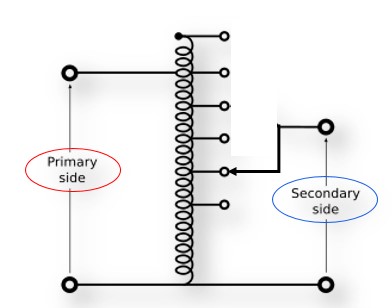How does an electric autotransformer work?
An electric autotransformer is a type of transformer that has a single winding with multiple voltage taps. It operates based on the principles of electromagnetic induction.

When an alternating current (AC) is applied to the primary side of the autotransformer, it creates a magnetic field in the winding. This magnetic field induces a voltage in the winding, which is then transferred to the secondary side. The primary and secondary sides of the autotransformer share a portion of the winding. The voltage is transformed by the ratio of the number of turns between the primary and secondary sides. By tapping different sections of the winding, the autotransformer can adjust the voltage ratio.
An example: if the primary side has twice the number of turns of the secondary side, the secondary voltage will be half the primary voltage.
For step-down operation, the primary side is connected to a higher voltage tap, while the secondary side is connected to a lower voltage tap. This decreases the voltage on the secondary side compared to the primary side.
Advantages of autotransformer technology
The autotransformer offers some advantages over a traditional transformer. It is generally more efficient, as power is transferred directly between the primary and secondary sides through the shared winding. Additionally, it is typically smaller, lighter, and less expensive than a conventional transformer with separate windings for the primary and secondary sides. Due to the common winding, there is no galvanic isolation between the primary and secondary sides. There is a direct electrical connection between the primary and secondary sides, which means that if a fault occurs on one side, it can affect the other side.
Electromagnetic induction
Electric Transformers utilize electromagnetic induction to transfer electrical energy between different voltage levels. The autotransformer consists of a common winding that serves as both the primary and secondary winding. The winding is divided into different sections, and each section is connected to a tap. The tap points allow for variations in the voltage ratio.
Electromagnetic induction is the phenomenon through which a changing magnetic field induces an electric current in a conductor. It was first discovered by Michael Faraday in the early 19th century and is a fundamental principle of electromagnetism. According to Faraday's law of electromagnetic induction, when the magnetic field through a conductor changes, an electromotive force (EMF) is induced in the conductor. This induced EMF then leads to the generation of an electric current if there is a closed conducting path. The process of electromagnetic induction can be summarized as follows:
- Changing Magnetic Field: When a magnetic field passing through a conductor changes in strength or direction, it creates a changing magnetic flux.
- Induced EMF: The changing magnetic flux through the conductor induces an electromotive force (EMF) or voltage across the conductor. The EMF is proportional to the rate of change of the magnetic flux.
- Electric Current: If the conductor forms a closed loop or is connected to a complete circuit, the induced EMF causes electric charges to flow, resulting in an electric current.
